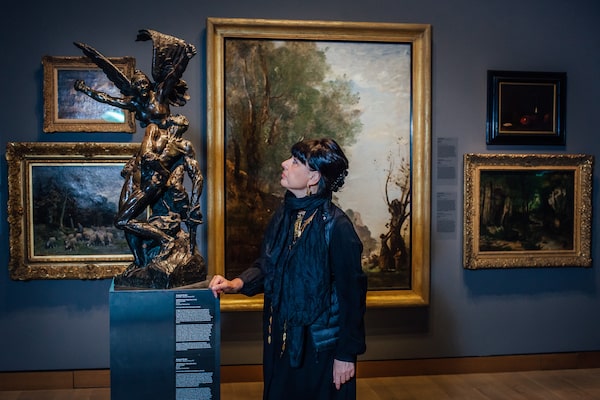
Nathalie Bondil, former director and chief curator of the Montreal Museum of Fine Arts.Valerian Mazataud
The director of the Montreal Museum of Fine Arts was dismissed by the board over a hiring dispute, not because of complaints of a toxic workplace, says the director of a U.S. gallery who has close ties with the Montreal institution.
Alex Nyerges, director of the Virginia Museum of Fine Arts, says he was given that reasoning in a recent conversation with Michel de la Chenelière, the chair of the MMFA’s board of trustees. Nyerges has worked with de la Chenelière at the French American Museum Exchange organization, and he collaborated with the recently dismissed director, Nathalie Bondil, on exhibitions over the past decade.
“Michel felt [the board] had the absolute authority, regardless, and they were going to put their person in that role,” Nyerges said in an interview.
The dismissal of Bondil last month as director-general and chief curator of one of Canada’s largest art galleries has sparked a fierce debate about the acceptable bounds of workplace behaviour and the degree to which boards of trustees should step into the inner workings of cultural institutions. The Quebec government has commissioned an investigation into the circumstances of Bondil’s dismissal, given the museum’s prominence in the province’s culture.
A central issue of the debate has been the reasons for her dismissal: whether it is, as the board has publicly said, in response to employees who complained that she had created a toxic work environment, or, as Ms. Bondil and her defenders say, because she objected to the board hiring a person for a senior role at the museum without her consent.
A spokesperson for the MMFA said de la Chenelière would not comment on the conversation with Nyerges.
On the board’s side, more than 100 current and former employees of the Montreal museum signed a letter on Monday in support of the decision to dismiss Bondil, saying she had fostered an unhealthy work environment and claimed credit for her subordinates’ ideas.
Richard Gagnier, head of the museum’s restoration department, said the employees signed and issued the letter because they believe that public debate over Bondil’s dismissal is getting derailed by the hiring issue, when those inside the museum feel it was all about intolerable working conditions. For example, Gagnier said his department was regularly consulted too late in an exhibition planning process to properly do its job of restoring and maintaining art objects. He said repeated requests for postmortems on exhibitions to avoid future problems proved fruitless.
“This is a cri de coeur from employees,” he said. “It’s coming from the base.” He added that the signatories had consulted neither their union nor the museum’s board before releasing the letter.
But Nyerges said that, any workplace issues aside, the board’s main hiring job was picking a director – and that anyone more junior than that should be the director’s choice. He said that the board of trustees should have acquiesced to Bondil’s choice for the newly created position of a director of the curatorial division.
“I can tell you, I would quit before I was forced into a situation like that,” he said, adding that it “goes against the grain” of how a museum should operate.
Nyerges said the dispute over hiring was the central reason he was given for the dismissal, and the issue of workplace tensions was presented to him as “tangential.”
The board’s original explanation for the dismissal on July 13 cited employee complaints that began the previous October, and which led to a report from an independent human-resources firm that described the workplace of the museum as “toxic.” As a result of the report, the board decided to divide Bondil’s job in two, with her keeping the role of director-general and someone else leading the curatorial team. In a previous interview with The Globe and Mail, Bondil said she accepted the change, but disagreed with the board’s choice of curator Mary-Dailey Desmarais for the promotion. She said she respected Desmarais, but had wanted someone with more experience for the job.
Nyerges said that, in a decade of working with Bondil, he had seen her “transform that museum from being a relatively unknown, smaller, less-relevant institution into being a powerhouse in North America.”
He said he is speaking out because he sees a trend of the leaders of cultural institutions being turfed by their boards for what he called “capricious” reasons. He said he is on a weekly call with the directors of the 15 largest art museums in North America, and his colleagues have not wanted to come to Bondil’s defence.
“More [directors] are reluctant and hesitant to be vocal,” he said. “I’m just not one of them.”
He said he welcomed the report of the Quebec government and hoped it would clear the air.
 Chris Hannay
Chris Hannay Kate Taylor
Kate Taylor